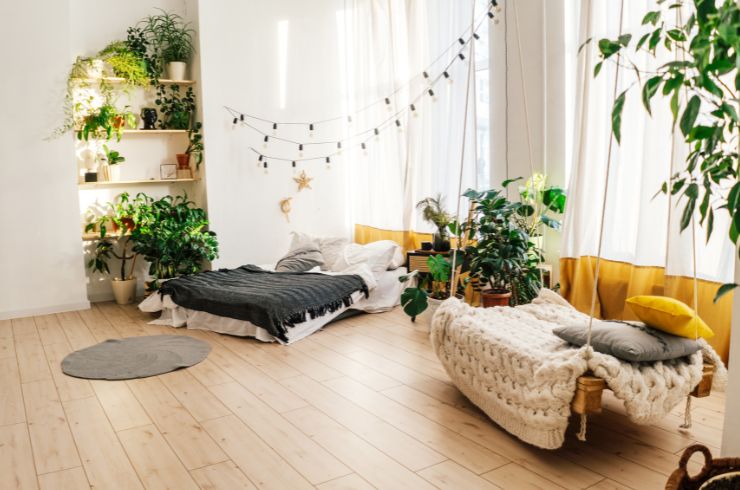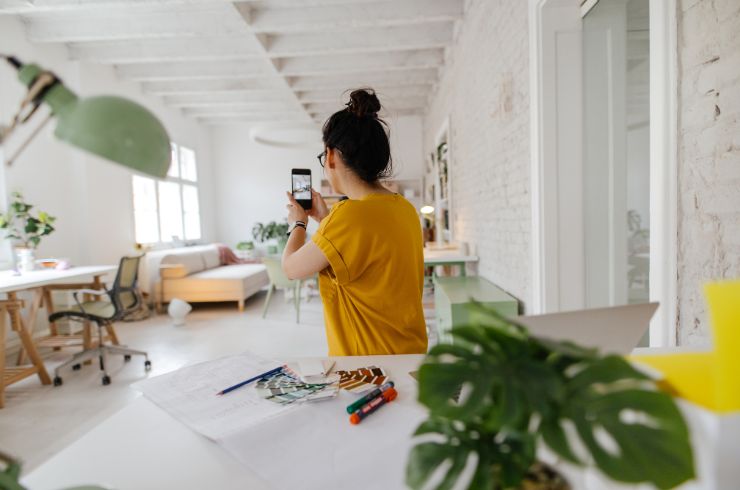Understanding the role of sustainable interior design is to enlighten and broaden an individual’s horizon to retain its sublime purpose, making the dream of an elevated form of living attainable. In a world where gloominess exists, there is room for hope, and the capacity of one single act of goodwill holds tremendous gains.
As the inherits of this vast globe we call home, we must preserve and spread harmony and take responsibility for our actions to bask in this gift. We can develop and maintain the function of the interior design industry in an eco-friendly manner. Taking our place among this diverse earth together, we can rise.
This article spotlights sustainability in interior design, its applications, and what makes it an important approach every architect must consider for a better tomorrow.
Sustainability in Interior Design: Why It Is Important?
An improved state of living. A vicinity where you can repose, enjoying the fruit of your labor.
To achieve such a status quo, understanding the role of sustainability in interior design is a matter of great urgency.
Green living and homemade recycled goods are two factors that any interior designer should consider as we head toward the future.
What Is Sustainability in Interior Design?
Sustainability in design is defined as assimilating objects and materials characterized by principles of verifiable economics and ecological sustainability into the interior design process. It’s the practice of creating environmentally responsible and aesthetically pleasing spaces. This approach considers the entire lifecycle of items to minimize negative environmental impact.
Interior designers can achieve sustainability in interior design using renewable, recyclable, and biodegradable materials. For example, they can use bamboo instead of hardwood for flooring.

Why Is Sustainable Interior Design Important?
Such an approach exhibits an ethical devotion to preserving the environment.
Additionally, solving environmental issues minimally saves time, effort, and cost, limiting the earth’s aftermath. Briefly speaking, it satisfies customers while creating a healthy method of environmental interior design, ensuring efficiency.
How to Implement Sustainability in Interior Design
The purpose of eco designs is to establish a collective awareness of the need for sustainability in interior design. Reclaiming materials typically built for singular use in a modern technique—a cutting-edge trend to refurbish furniture and appliances to meet living demands.
Generating energy-efficient equipment aids in greenhouse emissions.
Using natural light and solar energy promotes lessened consumption, and simple things like color choice eliminate depending on artificial light.
Moreover, working with recyclable materials that impose an imminent threat on natural resources can diminish carbon footprints and radio emissions, thus, reducing the consequences of the industrial revolution.
Luckily such solutions are available by managing and extracting different products and materials; thus, healthy spaces are within reach and obtainable.
Choosing Sustainable Materials in Interior Design
Conscious choices make all the difference; here are some materials to consider for your next sustainable interior design:
Bamboo
Bamboo is a long-lasting and enduring type of wood. It is a fashionable choice that will brighten the appearance of your home.
It is durable, adaptable to heat, and withstands swelling and shrinking. Convenient for your kitchen, living room, and bathroom. You can use it to make countertops, window screens, and stylish furniture.
Restored Woods
Save forests and stop tree cutting by reclaiming wood. Lesser waste and disposables mean that outdated wood won’t have to end up in landfills.
Style your house in antiquity giving it a vintage impression. You can utilize wood in flooring or a support beam that livens up the room.

Natural Stones
Incorporating nature gives a welcoming vibe to your home. Rustic can be new to introduce to your designs.
Granite, slate, and sandstones offer a variety of colors and shapes that make the perfect choice for wall cladding, Fireplaces, and decorative items.
Recycled Aluminum
Recycled aluminum gives a new meaning to a healthy indoor environment.
By minimizing pollution, carbon emissions, mining scars, and saving electricity, it is a unique decision to design a bold lighting fixture. It can also be used to build staircases and railings.
Energy Efficiency in Interior Design
Living in an energy-efficient house reduces the cost of utility bills. By incorporating energy-efficient lighting, appliances, and HVAC systems and maximizing natural light, interior designers can significantly reduce energy usage for their clients:
- Replace current lights with energy-efficient ones, like LED or CFL light bulbs.
- Consider the orientation of the building and utilize solar design techniques to reduce energy consumption. Sometimes, rearranging the furniture could do the job.
- Stack heavy libraries to act as a thermal barrier when positioned against walls.
- Check around windows for air leaks, doors, and electrical outlets, and use caulk or weather stripping to seal them.
- Add insulation to the walls, attic, and flooring to reduce heat loss in the winter and heat gain in the summer.
Improving Indoor Air Quality and Health
The sustainable interior design prioritizes using non-toxic, low VOC (volatile organic compounds) materials, which can significantly reduce the harmful chemicals released into the air.
Additionally, incorporating natural materials like wood and stone can further contribute to healthy indoor air quality.
Sustainable design can improve occupant health by maximizing natural light and views, providing access to nature, and creating spaces that promote physical activity and mental wellness.
Why Is Proper Ventilation Important in Interior Design?
Interior designers are now carefully considering the placement of operable windows and doors on different altitudes, using low air pressure to flow directly through spaces and exit from an opening at the opposite side of the building, creating a natural phenomenon called cross-ventilation.
This strategy improves air quality impacting human health, allowing the homeowner to enjoy a comfortable living experience without depending on HVAC systems.
Additionally, allowing natural light to enter the room regulates the body’s biological clock, guaranteeing restful sleep and creating a warmer, tranquil setting.
What Are The Benefits of Incorporating Natural Light Into Interior Design?
A new trend that explores the possibility of improving and regulating people’s mood is light therapy, AKA phototherapy, which treats (MDD) and seasonal depression by frequent exposure to direct sunlight or lights that mimic sunlight.

Try using a light box that’s colored yellow imitating natural light:
- Natural sunlight regulates the brain cycle by rewiring the biological clock’s circadian rhythm, a science field called chronobiology.
- It releases serotonin, a neurotransmitter that helps develop a healthy sleeping pattern and stabilizes mood.
- It also helps with attention span and tonic alertness.
Why Is It Important to Use Non-toxic Materials in Interior Design?
Using non-toxic materials in interior design is essential for promoting a healthy and sustainable environment.
Toxic materials, such as volatile organic compounds (VOCs) and formaldehyde, can cause various health problems, including respiratory issues, headaches, and nausea.
In addition to being harmful to human health, toxic materials can also harm the environment. Floors, furniture, and wall paint contain chemicals that drastically affect health resulting in diseases like hormone imbalance and congenital disabilities. It affects us so deeply that it may cause cancer in some cases.
What Is the Difference Between Green Design and Sustainable Design?
The green design focuses on reducing the impact of electricity, home appliances, and cement buildings. It enables an energy-efficient infrastructure, and its primary goal is to reduce the impact on mother earth, making sustainability in the interior design of great influence and importance.
Sustainable design is more concerned with the building itself, using recycled viable materials such as stone and glass; the goal is to produce a functional, long-lasting construction. In this regard, modern interior designers engage computer-aided technology like BIM and AR to help achieve sustainable designs, especially in enterprise projects.
An efficient AR collaboration tool for architects simplifies the visualization of architectural designs in real-time, ultimately contributing to the implementation of sustainability standards. It achieves this by facilitating accurate design processes, reducing waste, and promoting the use of environmentally friendly materials.
Why Is Sustainability in Interior Design Essential?
Preserving natural resources accounts for responsibility and a progressive and enlightened mentality. Living a gray life is a mediocre solution. Why live a life of mundane existence when you can experience a lofty estate?
Understanding your role and taking action will not only reward you with delight, but it will fulfill your soul. We owe it to ourselves and the next generations to come to incorporate sustainability in interior design.
There is a way when there is a will, and we have time to do right and correct our paths. Gather your family in the warmth of your new house and share the spirit of antiquity as you tell how you changed this world into a better place.
Conclusion
Picture the gaping abyss, make this space yours, and claim your place upon the green acres. Educate your fellow friends and explore infinite options for a healthier lifestyle.
Venture on the other side of technology and industrial living. Be one with nature as you step outside into the real world, let go of your accustomed habitual life and try new ways. You never know what will happen; you could be in for a great treat that’s friendly and eco-friendly sweet.




